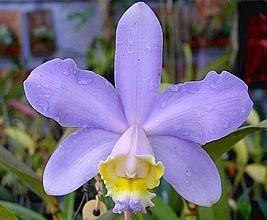Cattleya harrisoniana is a Brazilian orchid that finds its habitat in the Serra do Japi in São Paulo, extending to the lower part of the Serra da Mantiqueira and the mangroves of most of Baixada Fluminense, going up to the northern coast of Espírito Santo. This beautiful orchid species features slender, cylindrical, and grooved pseudobulbs that can reach up to forty centimeters in height. Additionally, it has two leathery, pointed leaves measuring about 25 centimeters in length, with a light green color. The highlight of its beauty is the erect floral stems that carry two to six generously sized flowers.
Each of these flowers displays approximately ten centimeters in diameter and a stunning dark lilac shade. Sometimes, confusion arises between this species and Cattleya loddigesii. However, it’s important to note that C. harrisoniana blooms during the summer, while C. loddigesii blossoms in the winter. Another notable distinction between the two is the golden-yellow color present on the lip of C. harrisoniana, near the junction with the petals. Although there are few known varieties of C. harrisoniana, the alba and the striata deserve special mention. Harrison’s Cattleya is also frequently used in hybridizations, contributing to the creation of new varieties.
The orchid C. harrisoniana is an epiphytic plant, preferring to grow rooted on tree trunks or in clay or xaxim pots. The ideal substrate for its cultivation is primarily composed of decomposed leaves and soft xaxim, although the latter has been replaced by coconut fiber in many cases. It also appreciates the use of wooden baskets to ensure a well-ventilated and well-draining growing environment. As for lighting, this orchid prefers partial shade conditions and benefits from a well-lit location, protected from direct sunlight between 11 a.m. and 3 p.m.
Regarding irrigation, it is important to maintain frequent watering in the early stages of seedling development. Later on, watering should be done whenever the soil is dry, reducing to once every two weeks during the colder months. As for fertilization, it is recommended to make biweekly sprays with a suitable soluble orchid fertilizer, such as Peter’s or PlantProd, following the manufacturer’s instructions. It is beneficial to alternate the formulation of fertilizers according to the natural growth, flowering, and maintenance cycle of the plant. The addition of chelated calcium is also important to strengthen the plant and make it more resistant to pests and diseases. Additionally, it is advisable to include organic fertilization, such as bokashi or seaweed-based fertilizers, to promote the healthy development of the orchid.
When it comes to propagating Cattleya harrisoniana, division of the plant is the preferred method. Ensure that each new seedling has at least four pseudobulbs, an intact rhizome, healthy roots, and a lead shoot. Avoid producing very small seedlings, as this can lead to their death or significantly delay their development. Position the rhizome cut on the pot wall, allowing the lead shoot to grow freely, ensuring space for the plant’s horizontal growth. Commercially, the multiplication of the species is carried out through seeds or meristematic cloning, contributing to the spread of this beautiful orchid in collections and gardens around the world.


